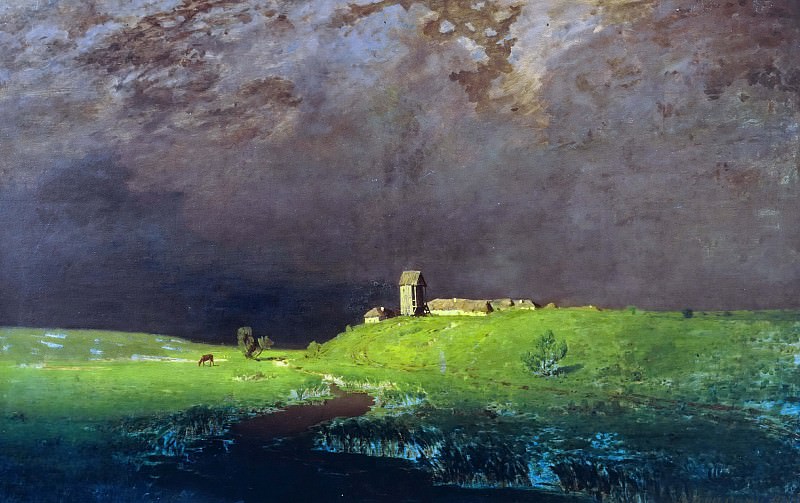After the Rain Arhip Kuindzhi (Kuindschi) (1842-1910)
Arhip Kuindzhi – After the Rain
Edit attribution
Download full size: 3364×2115 px (0,7 Mb)
Painter: Arhip Kuindzhi (Kuindschi)
Location: The State Tretyakov Gallery, Moscow (Государственная Третьяковская галерея).
Kuindzhi is a Russian master of landscape, nature in his paintings appears almost animate, a living being that exists in parallel with man. "After the Rain" depicts a farmhouse somewhere in southern Russia - nowhere else is there such saturated colors, an electric tension in the air that makes the hairs on the back of the neck stand up, where the most sensitive place is. Dark, heavy clouds hang over the world.
Description of Arkhip Kuindzhi’s painting "After the Rain".
Kuindzhi is a Russian master of landscape, nature in his paintings appears almost animate, a living being that exists in parallel with man.
"After the Rain" depicts a farmhouse somewhere in southern Russia - nowhere else is there such saturated colors, an electric tension in the air that makes the hairs on the back of the neck stand up, where the most sensitive place is.
Dark, heavy clouds hang over the world. They are painted with expression, like a seething cauldron of the most varied mixed colors. The rain just poured from them, the sharp blades of lightning sparkled, their clashes rumbled with heavy thunder. But now, the thunderstorm is over, and there is a gap in the clouds, a barely perceptible blue that is more of a premonition of clear sky than it is. This gap is enough for the sun to throw down shining rays. They illuminate, as with divine radiance, a patch of grass that seems like an earthly vision of paradise.
The farmstead itself is flooded with the same light. Small houses cling to each other, as if frightened by a thunderstorm, runs to the narrow, crowded river, the road. Not far away a lone horse grazes, and there are no people in the picture, only the full, wet feeling of the past thunderstorm, the exultation of nature that has experienced purification.
The Slavs believed that when thunder rumbled, the earth was married to the sky. The Scandinavians believed that it was the god Thor, the red-bearded man, riding his chariot across the sky and swinging his hammer at the creatures of darkness who wanted to take over the world. For all religions - pagan, tied to changes in nature - the thunderstorm was some supreme act of purification and love, and it is easy to understand.
After the rain, nature breathes freshness. The sun seems to shine brighter, and one breathes with a full chest so well that the air seems like intoxicating wine.
"After the Thunderstorm" captures this feeling perfectly. To look at it is to relive all the thunderstorms of my life.
Кому понравилось
Пожалуйста, подождите
На эту операцию может потребоваться несколько секунд.
Информация появится в новом окне,
если открытие новых окон не запрещено в настройках вашего браузера.
You need to login
Для работы с коллекциями – пожалуйста, войдите в аккаунт (open in new window).




















COMMENTS: 1 Ответы
очень замечательная картина
You cannot comment Why?
Below the imposing sky lies a vibrant, green field, shimmering with moisture. The grass appears freshly washed, its color intensified by the recent downpour. A winding stream or body of water snakes through the foreground, dark and reflective, mirroring the somber tones of the sky and contrasting with the illuminated field. A lone horse grazes peacefully in the middle ground, seemingly unfazed by the lingering atmospheric drama. Across the field, on a gentle hill, is a small cluster of rustic buildings, including what appears to be a wooden tower or belfry. The architecture suggests a rural, perhaps isolated, settlement. Small individual trees are scattered across the landscape, some appearing windswept.
The paintings subtext lies in its powerful evocation of transition and resilience. The dark, brooding sky represents the recent or impending challenge, the storm that has passed or is about to break. However, the intensely green and luminous landscape, along with the solitary animal and the quiet village, speaks of natures enduring beauty and the quiet continuation of life. The painting captures a moment of suspended animation, a pause between turmoil and calm, suggesting themes of hope, renewal, and the quiet strength found in facing adversity. The contrast between the dynamic sky and the serene earth creates a sense of awe and contemplation about the forces of nature and the human presence within them.